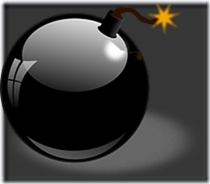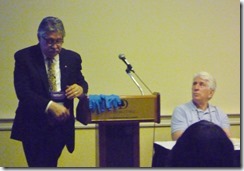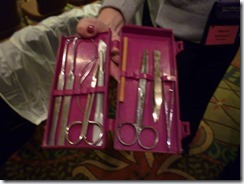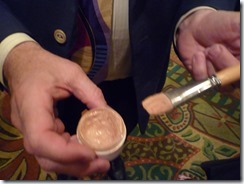Tag: mystery writing
Plot Twists
I always thought I wasn’t clever enough to come up with good plot twists. Short story writers have the market on this writing technique. Especially in the mystery genre, short fiction often relies on an unexpected twist for its punchline at the end.
So how can cozy writers come up with enough surprises to keep the reader turning pages? Sometimes you can plan ahead. I’ll write a synopsis before I begin writing the actual story. But something happens along the way. The characters, setting, and story elements stew in my brain, and out pops a surprise I didn’t anticipate. This is what I call story magic.
How can you get it to work for you? Review what you’ve written, and note any plot threads that you’ve introduced but failed to resolve. How about that minor character who makes a brief appearance on stage but whose role might be significant? Or the connection between two characters you didn’t expect? Or maybe a new character arrives on scene who upsets the balance among your suspects or your recurrent cast. Who is this person and how do they relate to the plot? To the other people in your story? Why did this person arrive at this time and for what reason?
In other words, pick up on clues that you’ve left for yourself. You’ll be surprised at what you find. If you are taken by surprise, so will your readers be amazed at your plot twists.
You can go back later and revise your synopsis accordingly. Meanwhile, go with the flow and see where it takes you. You’ll be pleased by your reviews when you have a few surprises along the way. Here are some of mine that are particularly pleasing in this respect:
“The story had more twists and turns than a pretzel. And I ate them all up! It is really fast-paced and kept me thoroughly engaged to the end.” Readeropolis

“I recommend this book to those who are cozy mystery fans and enjoy a sleuth mystery with many twists and turns.” Readers’ Favorite
“The storyline is fast-paced and keeps readers guessing to the end. There were several different twists and turns this story could have taken. I was surprised at the outcome.” Socrates Book Reviews
“You are always thinking and on your toes while reading this book. And when you get to the end and everything is revealed….it will blow your mind!” Cozy Mystery Book Reviews
“The story actually has a couple of mysteries within its pages and all is worked out by the end, but there are a lot of plot twists along the way.” Carla Loves to Read
“There were several twists and turns, plus many red herrings in this book. Just when I thought I knew what was going on, the author threw in a few extra curves to have me scratching my head.” Socrates’ Book Reviews
![]()
Sign up now for my latest book news, giveaways, exclusive bonus content, and events. Free book sampler for new subscribers.
Keeping A Series Fresh
Once you’ve written several books in your mystery series, it gets harder to come up with new and interesting material. The story has to engage your senses as a writer if you want to entice readers. You’ll want to avoid repetition such as means of murder and motives. And you need to vary the locales without going too far afield. Probably the most important element is to grow your characters. Let’s look at what you can do to bring excitement to each story in a long-term series.
1. Vary the setting within the setting. My Bad Hair Day cozy mystery series is set in fictional Palm Haven, Florida. But each story has its own milieu. Permed to Death, book number one, introduces hairstylist and amateur sleuth Marla Shore in her hair salon when a grumpy client dies in the shampoo chair. Subsequent stories involve a haunted hotel, a sports club, a wealthy family’s estate, a beauty trade show, a wedding and a day spa. Readers come to love the recurrent characters and expect to see them again, so you can’t deviate from the hometown too often. I’ve taken Marla and her husband, Detective Dalton Vail, on a Caribbean cruise and later on a dude ranch honeymoon in Arizona. For me, those stories are particular fun, but I can’t do them on a regular basis. Readers like to return to the same environment which becomes a character in itself. To avoid boredom, you have to take the same background and change it up enough to keep it interesting for you and your readers.
2. Avoid using the same murder method twice. Have you poisoned a victim already with a plant potion? Use snake venom next time. Or try shooting, hanging, stabbing, bashing on the head, pushing down the stairs, etc. Avoid repetition and be creative. Also vary the villain’s motives. You don’t want two stories in a row where a jealous lover did the deed. Think of your negative motivators—greed, envy, protection of a loved one, guarding one’s reputation, revenge, righting a perceived wrong—to provide variety.
3. Character growth is critically important. Your protagonists should evolve like people do in real life. Who surrounds them in terms of family, friends, and colleagues? How do their relationships change in each story? What’s the overall emotional journey for your main character? What new person can you add to spice things up? It could be a new friend, an old flame, a secret baby, a new boss, or a romantic interest. Keeping your main character static won’t work. The protagonist must continually adapt and develop expanding goals while letting insights guide her along the way.
4. Include a research or historical angle that excites you in a story. In Facials Can Be Fatal, I used excerpts from my father’s true life 1935 travel journal, which detailed his trip to Florida in simpler times. History plays a part in this story that includes tales of shipwrecks and pirates off the Florida coast. For Trimmed to Death, I’m researching olive oil scams. I am an olive fan so learning about this product interests me. Other topics I’ve explored have included the pet fur trade, biohazardous waste disposal, tilapia breeding, the prepper movement, and more. These tidbits of information snag my interest and provide something fresh for readers, too. Avoid info dumps, however, where you have long expository paragraphs with too much detail. Your research shouldn’t show. It should enhance your story.
5. Sprinkle in local issues or social problems that concern you. In Hair Brained, one character tells Marla about the risks to children left in hot cars. This is a big issue in Florida where child deaths from this cause are notable. It’s a preventable tragedy and I include tips for prevention in my story. My books also touch upon child-drowning prevention, another issue in a locale with so many backyard pools. These types of issues provide added depth to your story, but do it in a way that matches your chosen genre. If you’re writing humorous cozies, for example, things can’t get too serious. There are “edgier” cozies, but is this what you’re known for? You want to meet reader expectations. It’s okay to change things up once in a while but keep your author brand in mind and don’t stray too far.
6. Introduce enough of past events and relationships to clue in new readers when they pop into your series later down the road, but not too much that you give away previous plots. You also don’t want to bore your long-term readers, so keep this backstory to a minimum. It’s a delicate line to tread. Each story should feel like a standalone to newcomers but make fans happy to see what’s evolved personally for your characters in this latest book.
It gets harder to find a fresh angle as you get further along in your series. While avoiding repetition, you have to maintain the setting and characters that readers have come to love. What tips do you have to offer? As readers, how do feel about this topic?
Writing the Mystery – Howdunit?
When writing a cozy mystery, you need to decide upon crime scene details even though interpersonal relations and not forensic investigations are your story’s focus. Here’s an example of what this means. For my next book, I decided to start the tale at a bake-off contest, but the setting bothered me. Our city fairs are held on athletic fields or a flat stretch of grass in a park. This doesn’t leave much opportunity to stash a dead body.
I was telling this to my manicurist and mentioned that I needed a more interesting setting. She suggested Bedner’s Farm as a possible model for my story. The next day, my husband and I drove north to visit this farmer’s market in Boynton Beach. See my post for a report on this visit. The varied structures and grounds were ideal for my purposes, but I’d move my fictional site nearer to Marla’s hometown. Marla Vail is my hairstylist sleuth and the star of the Bad Hair Day Mysteries.


Now what? Francine Dodger is the target of the festival’s Find Franny scavenger hunt. I got this idea by looking up harvest festivals online. This drove me to research living scavenger hunts until I had an idea of how mine would work. Think about the five W’s when you’re in this phase.
Who ends up dead? Let’s say Francine is the victim.
Where is she killed? How does she arrive there? Is she lured on purpose, or it is a crime of opportunity? Did the killer follow her? Determine Where-dunit.
How does he do it? She could be drowned in a ditch. Water-filled canals line the U-pick rows. But other customers might be milling around there. Will it look like an accident or right away be identified as a homicide? She can fall down a silo. But what would make her climb up there in the first place? Or she could be runover by a tractor.
What knowledge does the killer need? If the murder involves an equipment accident, it’ll have to involve someone who knows to operate the machinery. Ditto the hazards inside a silo. You don’t want to point the finger at a particular suspect like the farmer, because it’s too obvious. Maybe give one of the other characters a secret history of working on a farm or of selling agricultural machinery.
If you poison a victim, who has knowledge about the type of poison used as well as access to it? Is it fast-acting enough for the circumstances, or do you need a slower more insidious death? What are the particular symptoms? Consider your means of murder very carefully when you’re making these decisions so your story will sound plausible.
When does it happen? Think about not only the time of death, but also why not a week or a month ago? Why NOW?
How does the killer get away? Does he have blood on his clothes? Are his shoes wet or muddy? Is he able to blend back into the crowd? How does he act when he encounters the heroine?
Now let’s throw a wrench into the works.
What if it’s a case of mistaken identity? He thought he had killed one woman but he got somebody else who was similarly attired. How will he react upon seeing his intended victim alive and well? This leads to another set of problems. It means he can’t see the victim’s face before he kills her, or he’ll realize it’s the wrong person. So again, we go back to Howdunit?
Once you figure out these details, you’ll have to determine how your amateur sleuth stumbles across the dead body. And this is when the story actually begins.
Writing the Cozy Mystery - Howdunit? Share on XSave
Save
Save
Writing the Mystery – Whydunit?
In the previous post, we discussed character development. As you figure out each person’s goals and secrets, you need to determine how that character relates to the others. Think of a spider web. The victim is in the center, and all of the other threads are the suspects. Or visualize it as a character wheel with spokes. Whichever model you choose, you’ll want to connect the characters to each other.
Here are examples from my WIP to show you how it’s done. The characters are involved in a bake-off contest held during the spring festival at a local farm.
Tally Riggs, my hairstylist sleuth’s best friend, met Becky Forest at a local historical museum. She told Tally about the bake-off.
Becky, a scientist, is a cookbook author and curator of the museum. She studies plant remains of ancient peoples, including early Florida food practices. Every time Becky has a new cookbook out, she’s a guest on Chef Raquel Hayes’ TV show.
Raquel, a judge at the bake-off contest and a TV chef, did something in the past that could scandalize her. Francine Dodger recognizes her on TV and threatens to spill her secret.
Francine, a contestant at the bake-off, is a food magazine editor. While researching an article on the farm, she uncovers something that could ruin the owners’ reputation.
Zach Kinsdale, eldest brother of four siblings who run the family farm, hasn’t told his two brothers and sister Janet about this looming disaster.
Janet is married to Tony, who runs an import-export business. He sells his imported olive oils to Zach for the farm’s marketplace. But Janet suspects something unethical about her husband’s business. She’s the one who organized the bake-off since her husband’s company is a festival sponsor.
Tony, Janet’s husband, is worried about an exposé that Francine has mentioned. He’s also concerned about Tristan Marsh, pastry chef at The Royal Palate and a judge at the show. Tristan has been making inquiries that concern him. He’s not the only one. Alyce Greene, a blogger who supports the farm-to-table movement, has been troublesome as well.
Alyce is a contestant at the bake-off. She’s married to Jon, a food truck operator. Jon got a loan to start his business from Alyce’s brother, Steve Madison. Steve, an investment advisor, manages Tony’s accounts.
And so on. You get the idea. It helps when the puzzle pieces fit together as a whole, but this process may take a while. In the meantime, allow your subconscious to stew on these ideas until story magic happens. The connections will pop into your brain. It’s a joyful moment when this occurs. It always does; you have to maintain faith in the creative process.
Now you know as much about these people as I do. Next comes Writing the Mystery – Howdunit.
End of Chapter Hooks
Creating a hook at the end of a chapter encourages readers to turn the page to find out what happens next in your story. What works well are unexpected revelations, wherein an important plot point is offered or a secret exposed; cliffhanger situations in which your character is in physical danger; or a decision your character makes that affects story momentum. Also useful are promises of a sexual tryst, emotional aftermath of a love scene, arrival of an important secondary character, or a puzzling observation that leaves your reader wondering what it means.
It’s important to stay in viewpoint. Otherwise, you’ll lose immediacy and this will throw your reader out of the story. For example, your heroine is shown in first person viewpoint placing a perfume atomizer into her purse while thinking to herself: “Before the day was done, I’d wish it had been a can of pepper spray instead.” What happens later on? This character is looking back from future events rather than experiencing the present. As a reader, you’ve lost the sense of timing that holds you to her viewpoint. You’re supposed to see what she sees and hear what she hears, so how can you observe what hasn’t yet come to pass? Thus you are tossed out of viewpoint while being forewarned things are going to get nasty.
Foreshadowing is desirable because it heightens tension, but it can be done using more subtle techniques. Here’s another out-of-body experience: “If I knew what was going to happen, I’d never have walked through that door.” Who is telling us this? The Author, that’s who. Certainly not your character, or she’d heed her own advice. Who else but the author is hovering up in the air observing your heroine and pulling her strings? Same goes for these examples:
“I never dreamed that just around the corner, death waited in the wings.” Who can see around this corner if not your viewpoint character? YOU, the author!
“Watching our favorite TV program instead of the news, we missed the story about a vandalized restaurant.” If the characters missed the story, who saw it?
“I felt badly about the unknown victim, but it had nothing to do with me. Or so I thought.” He’s speaking again from the future looking back.
“I couldn’t possibly have been more wrong.” Ditto to above.
“I was so intent on watching the doorway, I didn’t see the tall figure slink around the corner.” Then who did spot the tall figure? You got it–the author.
Although these examples are given in first person, the same principles apply to third person limited viewpoint. Your reader is inside that character’s skin. She shouldn’t be able to see/hear/feel beyond your heroine’s sensory perceptions. By dropping hints about future events, you’re losing the reader’s rapt attention. Avoid author intrusion by sticking to the present. End your chapter with a hook that stays in viewpoint.
Here are some examples from Permed to Death, #1 in the Bad Hair Day Mysteries:
“This was her chance to finally bury the mistake she’d made years ago. Gritting her teeth, she pulled onto the main road and headed east.” (Important Decision)
“There’s something you should know. He had every reason to want my mother dead.” (Revelation)
“Her heart pounding against her ribs, she grabbed her purse and dashed out of her townhouse. Time was of the essence. If she was right, Bertha was destined to have company in her grave.” (Character in Jeopardy)
“Her heart heavy, she crawled into her car. Until this case was solved, she couldn’t call anyone her friend.” (Aftermath of emotional scene)
[Heroine has been poisoned] “She allowed oblivion to sweep her into its comforting depths.” (Physical Danger)
“Todd Kravitz, the old lady’s son. Don’t you remember? He was the male model who posed with you for those sexy shots.” (Secret Exposed)
The same techniques apply to romance novels as well as mysteries. Ending a chapter with a confrontation between the hero and heroine will make the reader turn the page, especially if you’ve presented only one character’s reaction. Anticipation rises for the other person’s response. How will this event change their relationship? In addition to emotional turning points, escalating sexual tension will keep your reader eagerly flipping pages.
Decisions that have risky consequences can also be effective. For example, your heroine decides to visit her boyfriend’s aunt against his wishes. She risks losing his affection but believes what she’s doing is right. Suspense heightens as the reader waits to see if the hero misinterprets her action. Or have the hero in a thriller make a dangerous choice that puts someone he cares about in jeopardy no matter what he does. What are the consequences? End of chapter. Readers must keep going to find out what happens next.
To summarize, here’s a list of chapter endings that will spur your reader to keep the night light burning:
1. Decision
2. Danger
3. Revelation
4. Secondary character’s unexpected arrival
5. Emotional turning point
6. Sexual tension
7. Puzzle
Sprinkle the lucky seven judiciously into your story and hopefully one day you’ll be the happy recipient of a fan letter that says: “I stayed up all night to finish your book. I couldn’t put it down.” That’s music to a writer’s ears.
CLICK TO TWEET
<><><>
GIVEAWAY
Nov. 1-18 Booklovers Bench
Enter to win a $25 Amazon/BN gift card from Booklover’s Bench
Character Archetypes
Archetypes are recurrent themes found in works of literature and film. Take the Star Lord and the green-skinned girl in Guardians of the Galaxy. He’s a cocky womanizer. She’s a feminist warrior. Don’t you love their snappy dialogue before they realize how much they care for each other? Here’s a list of other familiar archetypes.
AMNESIA: Is he/she married, a parent, a missing bride/groom, presumed dead? Did he kill someone? Did someone try to kill him? Is she a witness to a violent crime? Is he an undercover agent who got hurt by the bad guys? American Dreamer, The Bourne Identity
BRIDES: Marriage of convenience, fake fiancés, mail order bride, runaway bride/groom, green‑card, royal, shot-gun wedding, jilted, terms of the will, mismatch, Vegas spur-of-the-moment wedding (or hasty drunken decision). Runaway Bride, Father of the Bride, Wedding Crashers, Sleepless in Seattle, What Happens in Vegas
BUDDIES/PARTNERS: Two or more pals go on a road trip and have a wild time.
CHILDREN: Abandoned, lost, orphaned, adopted, biological, inherited, stolen, kidnapped, secret baby, true identity unknown, switched‑at‑birth, kids playing matchmaker for single parents. Home Alone
DISGUISE: Hidden identity, switching places, surprise identity: True Lies, The Prince and the Pauper, The Scarlet Pimpernel, Freaky Friday, The Princess Diaries
FISH OUT OF WATER: Enchanted, City Slickers, Kate and Leopold, Outlander
MAKEOVER: The Princess Diaries, My Fair Lady
MISMATCHED COUPLES: Bad boy/Good girl, Cowboy/Lady, Pirate/Princess, Real Estate Developer/Preservationist, Wanderer/Homemaker, May/December, Womanizer/Feminist, Duke/Governess, Mentor/Protegé, Boss/Employee. Romeo & Juliet, Beauty and the Beast, Six Days Seven Nights
RAGS TO RICHES: Cinderella, Pretty Woman, Ever After, Maid in Manhattan
REUNION: Former lovers, estranged spouses, lost love, thwarted romance, divorced but still in love. Sweet Home Alabama
SECRET POWER: Harry Potter series, Superheroes like Superman and The Flash
SINGLE PARENTS: Struggling working mothers, clueless divorced dads. Three Men and a Baby, Baby Boom. Many of the Hallmark TV movie rom coms.
TWINS: Switched identities, mistaken identities, trading places to fool people and having the tables turned on them instead. Parent Trap, New York Minute
Think about the books on your shelves at home. Do you repeatedly buy the same types of stories? Does this tell you something about the plot devices that appeal to you? Have you ever tried writing a story with your favorite theme?
Now let’s see how this applies to writing a murder mystery. As a writing exercise, select a theme above and randomly pair it with a setting mentioned in the post below. What do you get? Can you weave a mystery around this combination?
For example, “Rags to Riches” meets “Library.” So…we have a Cinderella-type woman who is hoping to better herself, so she gets a job in an important library where she means to meet a guy. Think government center or historical library, not just your average small town place. But instead of meeting the man of her dreams to escalate her social status, she stumbles across a dead body in the stacks. What’s worse is that she’s accused of the crime. You see what I mean? Now share your combination and how you’d plot a story.
CLICK TO TWEET
Raising Suspense in your Novel
How to increase suspense in your novel was the topic of a Saturday panel at Sleuthfest. Speakers included Laurence P. O’Bryan, Chris Pavone, Charles Salzberg and Alison McMahan as moderator.
What you want to do as a writer is to raise questions in the reader’s mind. You say things, but you don’t explain all of them. Follow the principle of R.U.E.—Resist the Urge to Explain.
Start out the story with a bang. Don’t give all the backstory right up front. Respect the reader to figure things out on his own. Create situations to make the reader care about your character’s backstory. This history can come in during “down” times in the pacing but only in small doses.
Contain mini-mysteries within the overall plot. Give solutions along the way to keep the reader interested, and then raise new questions.
Guide the reader down blank alleys but not too many of them.
Sentences should have velocity.
Leave out the paragraphs readers will skip over. Don’t dump info like descriptions of places or people unless it serves a purpose.
Spread out character background. Reveal things sparingly in terms of character and place.
Mood and temperament of the sleuth can add to the suspense. How is he going to behave? Will he act morally? Relationships add tension. Action shows a character’s true motivation.
Adding a ticking time bomb or a deadline or using bait and switch tactics are other methods to raise suspense. So can a sense of menace, but be subtle. For example, you mention that a character is meeting someone on Monday. Who is he meeting with? What’s going to happen?
“Our job is to keep people reading. Each chapter should have an arc that doesn’t resolve.”
<><><>
Disclaimer: These notes are my interpretation and are subject to errors which are mine alone.
View photos from Sleuthfest on my Facebook page. Look for the Sleuthfest 2016 album. Please Like the page while you are there.
Contest Alert!
Enter to win a $25 Amazon/BN gift card from Booklover’s Bench, where readers are winners. http://bookloversbench.com/contest/
Private Investigator in Training
ONE MAN’S SHORT, SKETCHY CAREER AS A PRIVATE INVESTIGATOR IN TRAINING by Tom Turner
I thought Contop Investigations was kind of an odd name for a private investigation firm when I went there for an interview thirty years ago. Turned out the head of the West Palm Beach P.I. firm had a romanticized idea of what he did for a living. What he did– Contop’s bread and butter, that is– was cheating spouse investigations. That entailed putting a GPS device on a suspect’s car and following him/ her– usually him– to a No-tell Motel, then getting out his hire-powered Nikon and snapping off a few rolls of incriminating photos. (To his credit, he never actually went so far as to shoot a couple in compromising positions.) How do I know? Because I worked there for four months. When you’re twenty-five and broke, well, your standards maybe aren’t as lofty as they might be.
Anyway, so back to the name. The head of Contop– let’s call him Art– was a prodigious reader, particularly of detective novels, and confided in me once, after about nineteen Budweiser’s, that he named his company after the Continental Operative, Dashiell Hammett’s cunning master of deceit. He told me it was between Contop or Black Dahlia Investigations, which he’d lifted from a James Elroy noir novel. My tenure at Contop was mercifully short because Art had an explosive temper and a seriously sleazy side. The latter became readily apparent in a phone call I overheard between Art and a prospective client: “Yeah,” Art said, “it’s just me and my wingman, Tom, here at Contop. He’s specializes in background checks and technical surveillance and put in sixteen years with the FBI.” Oh, really? So that meant I was nine when I joined up and…. “technical surveillance?” What’s that all about? But the actual reason I quit was when he told me to “put a tail” on a cheating spouse– who turned out to be the father of a girl I had, coincidentally, dated the year before. I mustered up all my courage and told Art I wasn’t going to do it. He stormed around and told me I wasn’t cut out for PI work. He was right… thank God.
Palm Beach Nasty
New York homicide cop, Charlie Crawford, burns out, goes south and ends up in glitzy, glamorous Palm Beach. Problem is no one ever gets killed there…until one day Crawford is first on scene and finds a young guy swinging from a stately banyan tree. With that gruesome discovery, Palm Beach Nasty is off and running, with crisscrossing plots involving a billionaire with a thing for young girls, a far-reaching art scam with Crawford’s ex-girlfriend playing a starring role, and a ruthless hustler passing himself off as the long lost son of one of the richest men in town. Add to the mix a sultry real estate broker who knows where all the bodies are buried, a gorgeous forensic cop who’s got her eye on Charlie, a Mutt n’ Jeff combo of stone cold killers and you’ve got Palm Beach Nasty. Fast-paced, funny and a ton of fun… plus everything you ever wanted to know about the most scandalous town in America.
About the Author:
A native New Englander, Tom Turner ran a bar in Vermont after college, then moved to New York and spent time as an award-winning copywriter at several Manhattan advertising agencies. A few years later he made a radical change and ended up in Palm Beach, buying, renovating and selling houses. On the side, he wrote Palm Beach Nasty, its sequel, Palm Beach Poison, and a screenplay, Underwater, now in development with a Hollywood production company. While at a wedding, he fell for the charm of Charleston, South Carolina, and moved there. He recently completed his third novel, Killing it in Charleston.
Website: http://tomturnerwrites.com/
Blog: http://tomturnerwrites.com/blog/
Facebook: https://www.facebook.com/tomturner.author?fref=ts
Twitter: https://twitter.com/TomTurner1221
Buy the Book: http://amzn.com/1579623840
The Art of Embalming
SleuthFest Thursday, February 26, 2015
Thursday at SleuthFest is a day of special workshops. I got there after lunch and ended up at The Art of Embalming talk by George Rafaidus from Ford Funeral Home in Michigan. Attendees were treated to slides and descriptions of the embalming process, plus other behind-the-scenes details of how funeral homes prepare bodies. While it was a morbid topic, it was also a fascinating one. We received many handouts along with a show-and-tell of various props.
The Art of Embalming
Disclaimer: These notes are based on my interpretations. Any errors are unintentional and are mine alone.
Bodies are refrigerated from hospitals but not nursing homes. There’s more than one type of autopsy. There’s a partial wherein the thoracic cage is carved in the classic “Y” or there’s a cranial, like for Alzheimer’s patients or for medical studies. And then there is the double or complete autopsy. There may still be slight rigor mortis after 48 hours but that’s generally how long it lasts. Through washing of the body and manipulation, the stiffness lessens. The morticians need to know injection and IV sites, medical waste issues, birthmarks, and more, about the deceased. A trocar is a tool used to release gases and fluids from the body in the belly button area. Morticians shave people so they’ll look better for relatives.
How does the embalming work? They make an incision in the carotid artery, bring up the artery and inject embalming fluid. This part is done by machine. Up to 3 gallons of a formaldehyde and water mixture are injected in through the carotid and out through the jugular. This may take a couple of hours. The blood that is replaced goes through a filtration process before it’s released.
A dye in the fluid helps give the person a more natural complexion. Cosmetic enhancements may include a tissue fluid that works like Botox to fill in areas under the skin, so if the victim is emaciated or ill, they’ll look better for viewings. They may prepare the face with eye caps and mouth-formers. Look in the upper right corner of this photo to see these items.
If the person is being cremated, they could still have a visitation and viewing prior to the cremation. They could have a memorial service and embalming as well. Even if it’s a closed casket funeral, they would do the same, because a relative has to come in to identify the deceased. Difficult cases are trauma or accident victims. Regarding cosmetics, normal cosmetics have bluing agents that may distort a person’s color. So they use special makeup that’s like a foundation and brush it on the skin. (It’s sort of gummy and has an unpleasant odor—we tried it on). Waxes may also be used.
The state may dictate when embalming has to take place. Usually it’s at 48 hours. Embalmers are licensed. There are 38 mortuary schools throughout the country. A vault holds the casket to protect the body from the elements. The casket is labeled with the deceased person’s name, its burial location in the cemetery, and the name of the funeral home. In cases of flooding, this helps to identify the casket and where it belongs.
After the lectures finished, we were welcomed to Sleuthfest by Conference Co-Chairs Joanne Sinchuk and Vicki Landis.
Then publisher Neil Nyren spoke on Myths and Truths About Publishing.
Sleuthfest 101 Dinner followed, where we got to meet and mingle over a meal.
Coming Next: The agents and editors panels
View my SleuthFest 2015 photo album at https://www.facebook.com/NancyJCohenAuthor and Like my page while you’re there.
























